Is Barry Mandel the Michael Jordan of Development?
Barrett rhapsodizes over developer at groundbreaking of North End III. And Fresh Thyme owner adds praise of Mandel style.

On Monday, October 13, Mandel Group broke ground on the third phase of The North End. Photo by Michael Horne.
For the third time in ten days the silver shovels were hauled out of the Mandel Group vault for a groundbreaking, this time for Phase III of The North End, a mixed-use development on the former site of the Pfister & Vogel tannery in Downtown.
“With Phase III, we now have a critical mass [of population density]. This was the hole in the doughnut Downtown,” Mandel Group President Barry Mandel told a group of 100 who assembled on the site Monday, October 13th, to witness the event. “Finally we weave together the urban fabric, create jobs and an ongoing tax base for the city.”
The “doughnut hole” was a blighted, undeveloped area between the Milwaukee River and N. Water St. north of Downtown. Development had taken place in every direction around the old tannery, but this largest downtown brownfield seemed immune to improvement. Mandel’s involvement began in 2001, he said, when then-Mayor John O. Norquist called and asked if he would like to buy the site.
The $53 million project includes $36 million of “extremely complex financing,” Mandel said, including $10.5 million in New Market Tax Credits from the Wisconsin Housing and Economic Development Agency, whose CEO Wyman B. Winston was among those on the floral-festooned podium with Mandel.
Those credits will be used to help finance a Fresh Thyme grocery store on the property. Winston said the area qualifies as a “food desert,” with virtually no full service groceries in the immediate area, particularly to the west.
A city Tax Incremental Financing district provided $8 million in public and private infrastructure for the project, including one-third of the $5.5 million environmental remediation tab and a riverwalk segment that will be a quarter mile long when completed.
The six-story building on the northwest corner of N. Water and E. Pleasant streets will have 168 apartments, including some moderately priced units that will be “seamlessly” woven into the development, Mandel said.
Currently, the firm has $120 million in projects under construction, he said, adding that “three to five deals are imminent over the next five to seven months, worth another $120 million.”
The new project will bring the North End complex to about 400 apartments and 45,000 square feet of retail space. Phase III will be ready for occupancy at the end of 2015. Upon complete build-out, the North End complex will have 675 homes and represent $175 million in private investment in an area that few had great hopes for.
Also at the event, Mandel announced that Richard “Dick” Lincoln, who served as master of ceremonies, would be retiring in December.
“If I had my way, Dick would retire on December 31st at 11:59 and 59 seconds, P.M.,” Mandel joked.
Lincoln gave the audience an idea of the demographics of the completed portions of the North End. He said the development, and others downtown, draw “young, educated, gainfully employed” professionals. Three-quarters of the residents are living Downtown for the first time. Many are reverse commuters traveling to jobs at Kohl’s, he said. Kohl’s, based in Menomonee Falls, has deferred plans to build a new campus in that remote area, yet also turned down city attempts to lure the fashion firm to Downtown, where it films its catalogues and advertisements.
Mayor Tom Barrett took the stand to commend Mandel on his work. Barrett likes little anecdotes to pepper his speeches, and he said that Mandel reminded him of Michael Jordan.
Say what?
“Did Michael Jordan ever tire of winning championships?” the Mayor asked, answering his own question in the negative. “For most people the North End would be a career-crowning accomplishment,” he said.
But not for our Barry! “Barry Mandel is the Michael Jordan of Milwaukee development.”
Now fully warmed up, the mayor also cited the proximity to both Downtown and the pastoral river. “People have an almost spiritual attachment to the river,” he said. “Even in the urban center you can experience the best of urban life and the wildlife and pristine areas” upstream, such as the Greenway Gateway now under construction on the west bank of the Milwaukee River just upstream from the North End project site.
The mayor’s words were echoed by Department of City Development commissioner Rocky Marcoux. “During the greatest recession since the Great Depression who was still building? Mandel,” he said.
Thanks to the recent pace of development here, Marcoux added, Milwaukee is the only Northern Tier city to show positive growth. “We are a city on the move in a way no other Northern Tier city can claim. “We have a 20,000 population downtown,” he said. Many of these people are “younger millennials who are waiting for the streetcar.”
While some private developers have been known to grumble about Marcoux and the city’s leadership, he declared the city’s development success is partly due to a good working environment between developers and the city, calling the relationship “effective and efficient teamwork. The development community should be able to expect that from the city,” he added.
Photos from the Groundbreaking
Grocery CEO Invites Public Input on New Store
Among the attendees at the North End Phase III groundbreaking was Chris Sherrell, the President / CEO of Fresh Thyme Farmers Market, a growing chain that believes “you shouldn’t have to give away the farm to feed your body nutritious food.”
The firm has 10 stores soon to open, with another 16 on the books and contracts for another 31 stores to come. “Six to eight” stores are planned for the Milwaukee market, he said, with a total of “ten to twelve” stores in the state.
Sherrell said with so many stores on the verge of opening, his staff wondered why he would bother going to a low-key event like a Milwaukee groundbreaking. Because the project captivated him, he said.
His stores have a “huge focus on produce,” Sherrell said, with 30 percent of the store space and 30 per cent of the sales being produce. His plan is to aid in creating “healthy lifestyles for the masses,” he said.
“It’s a new concept: value,” he noted. “It fits in perfectly with this project.” This is one of the few mixed-use developments he has been involved in, he said, and he is open to new ideas.
Sherrell offered a challenge to readers of Urban Milwaukee. “Tell me what you would like to see in the store,” he said. “There are some things we cannot change, but we welcome ideas about the store. For instance, would you like to see seating on the riverwalk?”
So here’s your chance to help plan Fresh Thyme. If you would care to take the challenge, add your comments here, and we will send them on. A grocery store design charrette might not be a bad idea.
Project Renderings
Political Contributions Tracker
Displaying political contributions between people mentioned in this story. Learn more.
- December 23, 2020 - Tom Barrett received $500 from Rocky Marcoux
- December 1, 2020 - Tom Barrett received $400 from Dick Lincoln
- December 1, 2020 - Tom Barrett received $500 from Barry Mandel
- December 31, 2018 - Tom Barrett received $400 from Dick Lincoln
- December 22, 2018 - Tom Barrett received $500 from Rocky Marcoux
- December 29, 2017 - Tom Barrett received $500 from Rocky Marcoux
- December 12, 2017 - Tom Barrett received $400 from Dick Lincoln
- March 1, 2017 - Tom Barrett received $400 from Rocky Marcoux
- November 18, 2015 - Tom Barrett received $400 from Dick Lincoln
Plenty of Horne
-
Milwaukee Modernism Gains National Awards
 Dec 15th, 2025 by Michael Horne
Dec 15th, 2025 by Michael Horne
-
New Rainbow Crosswalks Mark Milwaukee’s LGBTQ+ History
 Oct 8th, 2025 by Michael Horne
Oct 8th, 2025 by Michael Horne
-
Welcome Back, Tripoli Country Club!
 May 27th, 2025 by Michael Horne
May 27th, 2025 by Michael Horne


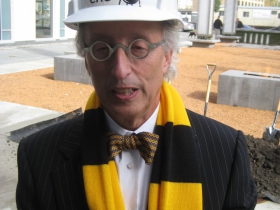
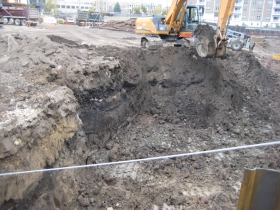
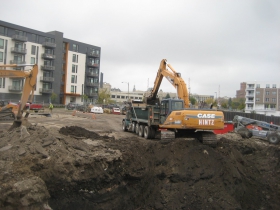
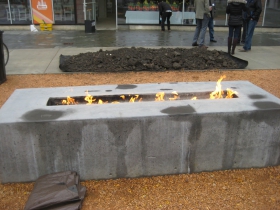
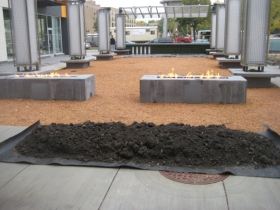
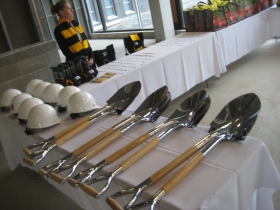
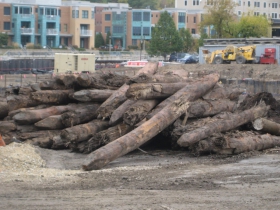
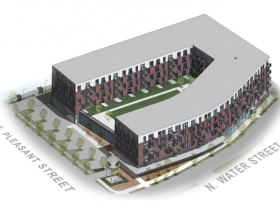
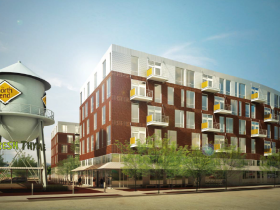
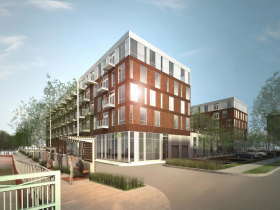




















Activate the river walk as much as possible. Seating, open sightlines from the store on to the river walk. Also, why not have another store that offers a nice mix of tap beer available in growlers?
How about growing on the unutilized rooftop? I realize that, at this point in the development, its too late to add the necessary access and infrastructure to make that happen – but wow that would have been a story. This is already a terrific win all around for the City, and I’m thrilled by the project for so many reasons. But just imagine…. the green growing roof could capture all the rainwater that will fall on that hardscape and rather than plowing it back into the combined storm/sewer system, it could have been redirected to gardens. Keeping the river water cleaner and growing food – sold right on site. Sadly – it looks like its just gonna be a traditional roof. Maybe on the next one Jordan/ Mandel?!
I agree. Not only are rooftops environmentally friendly, they are also a great amenity for residents in a downtown location. The Wangard development just west of Eastpoint has a rooftop deck.
How exactly does the area qualify as “food desert” with “no full service groceries in the immediate area, particularly to the west” with Pick & Save blocks away? The Third Ward must be described as an arid wasteland!
Yea, I found the food desert comment a little strange. Certainly west of the river but not east.
@CJ west of the river there are no grocery stores. The nearest store west of the river is probably the Save On Foods at 19th and Clyborn.
According to my very scientific analysis it is just over 700 feet from the North End Phase III site to Pick N’ Save’s full service grocery store located at 605 E Lyon St. Also, only another two blocks to Metro Market.
Nothing against this development and Barry Mandel, it and he are great for the city. However, don’t play like you’re helping alleviate issues of food access when you’re doing nothing of the sort. You want to see a real food desert stop by my house on the near west side and I’ll show you what my neighbors have to do in order to buy groceries.
I agree Dan, making a statement that an area has “virtually no full service groceries” when you are referring to the area west of that without easy access (it’s quite a walk from residential areas to the west and has only one westerly bus route nearby) is quite a stretch… seems like those credits could have gone to better use.
Great ideas about utilizing the rooftop. It will, in fact be another of the largest green roofs in the city. Instead of being farmed for the store it is being activated for the residents, including not only social spaces but as well inclusive of herb and flower gardens curated by the residents themselves. Fortunately, a huge component of the Fresh Thyme business model is purchasing grown goods from local growers. So, rather than doing it themselves, they’re leaving the rooftop to the residents and extending their financial reach out into the community of local growers whose product will become a part of the product sold.
I do think that this project is definitely a good thing. However, the idea that a Fresh Thyme is going to alleviate a food desert issue to the west of the river is silly. This is a grocery store in the vein of Trader Joe’s or Whole Foods, which means that for many people west of the river (who are not as well-to-do as the downtown folk), this is a specialty grocery store that will be expensive and have limited variety. The Pick N’ Saves on Van Buren and North Avenue are much more able to alleviate food desert issues simply because they’re more affordable and much larger. I’m not saying that Fresh Thyme is bad on the face of it or anything, but I just don’t see it helping that situation. It’s also across the river, which has always been a serious geographical divide in Milwaukee. So it’s not that walkable, especially if you are stocking up on a lot of groceries. And if you’re driving… Pick N’ Save is three blocks away. Build the Fresh Thyme, that’s fine, but don’t pretend it will be something it’s not.
Even more concerning is Barret’s comment that people are “waiting for the streetcar.” Streetcars are flashy, but incredibly inefficient as a source of transportation, and to suggest that we’re in deep need for a streetcar when food deserts are mentioned shows… cognitive dissonance? Hypocrisy? A lack of priorities? Streetcars improve public transportation for a select set of people – namely, those with money who would want to move throughout downtown for mostly recreational reasons. And while many people argue that streetcars increase the overall number of transportation linkages, I doubt that many new streetcar users – those who did not take a bus before – will then hop on to a city bus. Streetcars move slower than buses, can’t leave their route, carry less people, and cost many times more than buses.
We can improve public transportation by increasing buses, and by providing dedicated bus lanes. A streetcar can’t do anything a bus can’t, except that it looks cute, has millions and millions of federal dollars backing it, and sheds the (unfounded) negative image of buses that many yuppies have. If you really want premium public transportation in downtown, then we could have three dedicated, brightly-colored, nicely-furnished buses following the same route for a small, small fraction of that cost. So tell the the people in the food desert that downtown is getting a streetcar and see if they care – they won’t.
Fixed transit does have a positive economic impact in areas that it serves. Studies show that property values increase along corridors with fixed transit (streetcar) vs. in many cases a devaluation of property along bus corridors. It also is a catalyst for development. Most visitors will not hop on a bus in a strange city. That’s just the truth. They’re confusing and intimidating for many people. I remember when the County bought some nice rubber tire trollies to serve downtown and the surrounding neighborhoods and talk radio went ballistic. The County killed the project becasue on the bad press. Well be careful what you ask for.
Milwaukee does have a robust and efficient bus system. It is especially so in the central city. The problem is, at least according to some, is accessibility throughout the region. For example, its very difficult to get from N. 19th St. to Waukesha. The streetcar is not going to fix that problem. The spatial mismatch is a political issue within the region. It will, however, adress the issue of moving visitors and residents throughout the downtown and surrounding areas like the Lake, museums, restaurants, 3rd Ward, train station, convention center, Brady St, etc. And why is that not a good reason to build the streetcar. Visitors and tourism is big business here and growing. Why not nurture and grow that industry? BTW, fix transit, once implemented is our best opportunity for real regional transit. People that constantly argue against this investment will clamor for an extension once its built.
Tom, a streetcar does some things better than a bus:
– It reverses (at the end of the line) without wasting time driving up to 4 extra blocks looping around. On a short route like Milwaukee’s, this time-saving is significant.
– It doesn’t detract from sidewalk cafes along its route (buses are noisy like trucks and their diesel exhaust stinks).
– It handles better in ice and snow than a bus.
– Its fully-loaded capacity is 3-to-5 times as many people as a bus (at roughly the same per-vehicle operating cost)
– Its route is easier for visitors to grasp and try.
– It has a more pleasant, better-quality ride. While buses “ride” worse than cars, streetcars ride better and are more likely to entice people from automobiles. Some people get motion-sick reading on cars and buses but have no problems on streetcars.
Streetcars are faster than buses. Streetcars average about 9 mph downtown (including stops) compared to 6 mph for MCTS buses. They are faster than MCTS buses for six reasons:
– Their electric motors accelerate faster than diesels.
– They have more doors and allow passengers to board (and exit) through all doors, reducing time at stops.
– They reliably stop at exactly the same place every time, allowing curbs to be built at the exact streetcar floor height providing faster (step-free) entry and egress (like an elevator).
– Fares are paid in advance (at curbside vending machines) eliminating boarding delays while others count coins into a farebox.
– Unlike buses, they don’t waste time “kneeling” at stops.
– They don’t waste time pulling out of traffic to pick up passengers, followed by more time lost waiting for a break in traffic to merge back in.
I do think that the streetcar is good for residents and visitors along its route – how could it not be? – and for visitors who will view it is a friendly mode of transportation. And of course, streetcars can improve property values. But this isn’t a given just because a streetcar is built.
For one, streetcars generally serve areas that already have economic momentum, so the streetcar itself is not necessarily the driver of growth – a streetcar making the rounds through a depressed area is nowhere near as useful as a streetcar in a busier, better-off neighborhood. Even more so, many successful streetcar routes (think Portland) come with massive subsidies for new business located along the lines, which is the primary driver of why they’re successful. The streetcar helps, but the subsidies are the real draw. This throws into question the true value of the streetcar. You also have to wonder, does the streetcar bring net new business to the area? Or does it shift the location of business throughout the city? If I want to open a business in a popular part of town, is the streetcar necessary to my business’ survival? Wouldn’t my business be able to survive in another popular, streetcar-less part of the city (Bayview, Upper East Side)? Or even in the same party of the city without a streetcar?
But for the sake of argument, let’s assume that we want some kind of short-route, downtown public transportation. I agree that people are afraid of buses, but that’s due to the route, not the bus. Look at Madison. The free buses that are run by UW and the city are clean and quick, have a dedicated lane through downtown via State Street, and have a computer voice guy that reads out every stop before you get there. Or look at Denver, which has free buses running for about a mile up and down its downtown outdoor mall. Or even look at London – the buses are unique, pretty well-kept, and many have modern updates. The city is sprawling, and is in no way laid in a grid pattern like Milwaukee. Visitors ride them every day of the year.
It’s the route that makes the difference, and if the route is simple – which the proposed MKE streetcar route would be – then riders should have no problem with higher-quality buses, whether resident or visitor. Paint the buses in a unique way, maintain quality upholstery, and have unique, well-lit, visible bus stops with a bus tracker. Milwaukee will save a fortune.
We do agree to expand public transit, and I do think we agree that it should be done efficiently. A streetcar is very inefficient.
Assuming that those numbers are true in terms of speed – which I don’t know where they are sourced from, and they aren’t necessarily true about downtown Milwaukee – is that marginal improvement worth millions upon millions upon millions of dollars? More so than buses? And we have to consider that a dedicated downtown bus loop would give us modern buses rather than regular city buses. Such a plan would also call for improving bus infrastructure for a downtown loop – widening or dedicating bus lanes, creating more bus-accessible curbside pull-off areas (rather than standard city sidewalk curbs), having dedicated turnaround areas, and having the option of increasing or decreasing the number of buses on a route during a given time. So there is still a potential increase in speed and convenience that would come with using buses instead.
Milwaukee is not a city that should spend so much for something that is not a truly vetted system of public transportation. I am not a debt scold when it comes to many issues, but cities – which can and do go bankrupt – have suffered a lot since the financial crisis, and a city like Milwaukee, which is more poor than Portland, should be very discerning and cautious when it comes to spending money like this. Even a city like Portland – mecca for the American streetcar – had to take on a large amount of debt to finance its streetcar and subsidies for its route. The city’s once-solid fiscal standing is now shakier. Even assuming the city wouldn’t have to take on debt, is the streetcar really a wise use of funds in a city with bigger problems of poverty? So while I agree that public transportation can bring people to downtown – maybe to live, maybe just to visit – it doesn’t have to be a streetcar.
Tom, you asked where I got the 6 mph speed for MCTS…
I got it from Google Maps. I just asked for directions from Van Buren and Wisconsin to 11th and Wisconsin–a straight shot along about a half-dozen MCTS bus routes.
By car it takes 4 minutes, by bus it takes 12-14 minutes (at this time of day, anyway). It is 1.2 miles, so 4 minutes by car is 18 mph (slower than 30 mph because of traffic signals). By bus 12 minutes is 6 mph (because of traffic signals and time spent at bus stops), and 14 minutes is 5.1 mph.
You make good points. I guess my questions would be is there federal funding for the additional buses? We do not have dedicated funding for transit here and I don’t believe the current dollars can be transferred to buses. How would we pay the infrastructure costs for bus only lanes and come up with the millions for new and unique buses? Also, there is NO WAY buses would get dedicated lanes in the city. Not that I disagree with you but I don’t see it. I think bus rapid transit with dedicated lanes on the freeways would make more sense.
There was a proposal a few years back that was a compromise. I liked it at the time. It was a trolly system that looked like a streetcar. It operated in dedicated lanes with an overhead catenary. Since it was rubber tired it didn’t require all the utility modifications and when it went over bridges the catenary dropped and it swith to diesel until it crossed the bridge. It did not have issues with steep grades and it felt, drove and looked very unique at a fraction of the cost. Walker killed the project when he took over as County Executive. That’s when the City took over the issue of transit in downtown area, changed the route and switched to light rail.
Tom, streetcar opponents claim that in Portland, subsidies triggered development, not the streetcar. The problem with that claim is that development closely followed the streetcar route, not the subsidy area.
Between 1997 (when the Portland Streetcar route was finalized and publicized) and early 2008 (when a report was issued), 55% of all new Portland CBD development took place within ONE BLOCK of the streetcar. Prior to 1997, those same blocks captured 19% of CBD development.
Prior to 1997, new development within one block of the eventual streetcar route averaged less than half of its maximum allowable density. Between 1997-2008, new buildings within one block of the streetcar averaged 90% of maximum allowable density. As you move away from the tracks, the density drops off (but the subsidy remained the same). Two blocks away, projects averaged about 70% of maximum allowable density, three blocks away, about 60%, and more than 3 blocks away about 43%.
http://www.portlandstreetcar.org/pdf/development_200804_report.pdf
Tom, you suggest building a better bus route downtown instead of the streetcar–with “high quality upholstery”, “unique, well-lit, visible bus stops with a bus tracker” and a unique exterior paint scheme. That’s well and good, but not cheap.
Cleveland tried that and ended up spending roughly, per mile, what Milwaukee’s streetcar will cost ($200 million for 6.8 miles).
Cleveland’s bus line is an unquestioned success. It is so good, that they were actually able to sell naming rights–a transit first. It’s called the “HealthLine” for its two private-sector sponsors: The Cleveland Clinic and University Hospital. Both pay for the right to put their logos on the bus exteriors.
Like rail transit, the Cleveland HealthLine has triggered development. According to Wikipedia (do you have a better source?), this $200 million capital investment triggered $5.8 billion in new development along its route within 5 years.